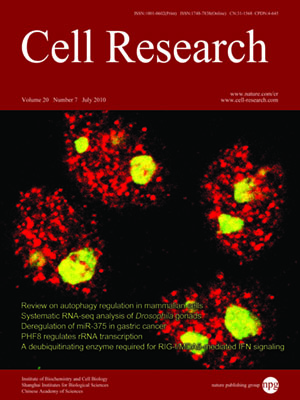
Volume 20, No 7, Jul 2010
ISSN: 1001-0602
EISSN: 1748-7838 2018
impact factor 17.848*
(Clarivate Analytics, 2019)
Volume 20 Issue 7, July 2010: 838-849
ORIGINAL ARTICLES
Rice DENSE AND ERECT PANICLE 2 is essential for determining panicle outgrowth and elongation
Feng Li1,2,*, Wenbo Liu1,2,*, Jiuyou Tang1,2, Jinfeng Chen1,2, Hongning Tong1,2, Bin Hu1,2, Chunlai Li1,2, Jun Fang1, Mingsheng Chen1 and Chengcai Chu1
1State Key Laboratory of Plant Genomics and National Center for Plant Gene Research, Institute of Genetics and Developmental Biology, Chinese Academy of Sciences, Beijing 100101, China
2Graduate School of the Chinese Academy of Sciences, Beijing 100101, China
Correspondence: Chengcai Chu,(ccchu@genetics.ac.cn)
The architecture of the panicle, including grain size and panicle morphology, directly determines grain yield. Panicle erectness, which is selected for achieving ideal plant architecture in the northern part of China, has drawn increasing attention of rice breeders. Here, dense and erect panicle 2 (dep2) mutant, which shows a dense and erect panicle phenotype, was identified. DEP2 encodes a plant-specific protein without any known functional domain. Expression profiling of DEP2 revealed that it is highly expressed in young tissues, with most abundance in young panicles. Morphological and expression analysis indicated that mutation in DEP2 mainly affects the rapid elongation of rachis and primary and secondary branches, but does not impair the initiation or formation of panicle primordia. Further analysis suggests that decrease of panicle length in dep2 is caused by a defect in cell proliferation during the exponential elongation of panicle. Despite a more compact plant type in the dep2 mutant, no significant alteration in grain production was found between wild type and dep2 mutant. Therefore, the study of DEP2 not only strengthens our understanding of the molecular genetic basis of panicle architecture but also has important implications for rice breeding.
Cell Research (2010) 20:838-849. doi: 10.1038/cr.2010.69; published online 25 May 2010
FULL TEXT | PDF
Browse 2310


